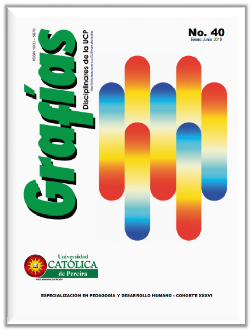Critical thinking for generation 4.0
DOI:
https://doi.org/10.31908/grafias.v0i40.2643Keywords:
Educational objectives, Critical Thinking, Robert Ennis, Generation 4.0Abstract
This paper presents Robert H. Ennis's theory of critical thinking as a more accurate proposal for the fourth industrial revolution. To achieve this objective, we start by examining the conception of critical thinking of the Ministry of National Education of Colombia (MEN), as a component of evaluation of the quality of education, identifying some assumptions. Then, Ennis's theory is presented, emphasizing his taxonomy of auxiliary abilities and dispositions, as attitudinal and ethical elements of the critical thinker. The comparison between both conceptions of critical thinking is framed in a final reflection on the challenges that generation 4.0 will face, to which a holistic view of human thought responds in a more pertinent way, which supports integral training processes in those who capabilities reflective do not isolate themselves from the behavioral and ethical.
References
Dewey, J. (1989). Cómo pensamos. La relación entre pensamiento reflexivo y proceso educativo. Paidós.
Ennis, R. H. (1985). A logical basis for measuring critical thinking skills. Educational leadership, 43(2), 44-48.
Ennis, R. H. (1996). Critical Thinking Dispositions. Their Nature andAssessability. Informal Logic, 18(2 y 3), 165-182.
Ennis, R. H. (2011). Critical Thinking: Reflection and Perspective, Part I. Inquiry: Critical Thinking across the Disciplines, 26(1), 4-18. https://doi.org/10.5840/inquiryctnews20112613
Facione, P. A. (1990). Critical thinking: A statement of expert consensus for purposes of educational assessment and instruction(The Delphi Report). California Academic Press.
MEN. (2006). Estándares básicos de competencias en lenguaje, matemáticas, ciencias y ciudadanas. Guía sobre lo que los estudiantes deben saber y saber hacer con lo que aprenden. MEN. http://cms.mineducacion.gov.co/static/cache/binaries/articles-340021_recurso_1.pdf?binary_rand=1223
MEN. (2009). Educación superior. Boletín informativo 13. Panamericana Formas e Impresos S.A.
MEN. (2011). Orientaciones para la institucionalización de las competencias ciudadanas. Cartilla 1: Brújula. Programa de competencias ciudadanas. Amado Impresores. https://www.mineducacion.gov.co/1759/articles-235147_archivo_pdf_cartilla1.pdf
MEN. (2012). Propuesta de lineamientos para la formación por competencias en educación superior. http://www.mineducacion.gov.co/1621/articles-261332_archivo_pdf_lineamientos.pdf
Nieto, A. M. y Saiz. C. (2011). Skills anddispositions of critical thinking: Are theysufficient? Anales de psicología, 27(1), 202-209.
Paul, R. y Elder, L. (2003). Laminiguía para el pensamiento crítico.Conceptos y herramientas. Fundación para el Pensamiento Crítico. http://www.criticalthinking.org/resources/PDF/SPConceptsand-Tools.pdf
Perelman, C. (1979). The Rational andthe Reasonable. Philosophical Exchange,10(1), 28-34.


